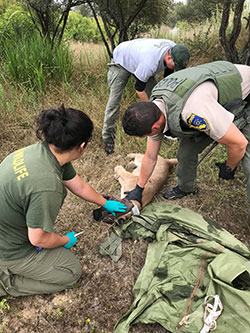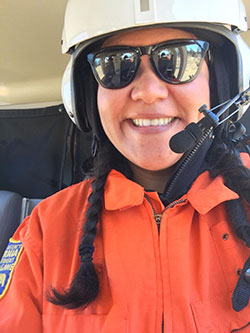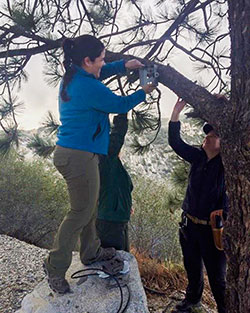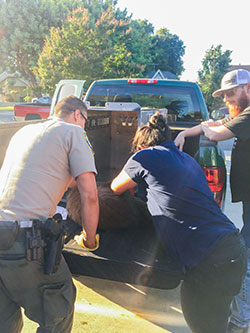It made perfect sense that CDFW environmental scientist Amelia Viera wanted to be a biology teacher. That was the high school topic she fell in love with, and she credited her teacher for making the subject so interesting. But it wasn’t long after getting her feet wet as a substitute teacher that she arrived at a slightly different career decision. She realized she wanted to practice biology, not just teach it.
Amelia Viera, at the scene of a mountain lion (not pictured) spotted in a tree in Los Angeles County.

Assisting in attaching a collar to mountain lion in the Santa Monica Mountains. Click to enlarge.

On aerial deer survey in San Diego County, Fall of 2019. Click to enlarge.

Putting up a trail camera for sheep survey near State Route 39. Click to enlarge.

Loading immobilized bear into truck for move to animal care facility. Click to enlarge.
It made perfect sense that CDFW environmental scientist Amelia Viera wanted to be a biology teacher. That was the high school topic she fell in love with, and she credited her teacher for making the subject so interesting. But it wasn’t long after getting her feet wet as a substitute teacher that she arrived at a slightly different career decision. She realized she wanted to practice biology, not just teach it.
Her degree in Anthropology was earned at UC Davis, but Amelia wanted to be closer to her family in Ontario. She returned to Southern California where she landed her first job with CDFW as a scientific aid. Now she’s a wildlife biologist, most often handling calls about bears and mountain lions straying a little too close to humans.
What’s a typical day for a biologist in Southern California? You must be on the road constantly.
There is no typical day since every day is different. I’m working in Los Angeles County so yes, a lot of that time is being stuck in traffic. I often go to foothill communities because they tend to experience the most human wildlife interaction. We get bears stuck on somebody’s property or a mountain lion that’s stuck in a tree on a property. I respond to those incidents with a wildlife officer just to be on the safe side, and we sometimes have to manage public involvement with a situation like that, because people are very curious about what’s going on.
What’s the biologist’s role in those situations?
I’m usually the one that does the immobilization. I’ll take the lead in making any necessary additional contacts if the animal is injured – for example, calling a CDFW veterinarian at the Wildlife Investigations Lab for a consult, or sometimes finding a local veterinarian. Once the animal is sedated, we do a quick assessment, take any vitals and make sure the animal is in generally good health. And then I decide where we release the animal, based on habitat assessment.
There are a lot of things to consider. For example, you don’t want to put that animal in another animal’s territory. We try to keep them as close to their capture location as possible. We want to release them where there’s shelter, food and water so the animal can thrive. Of course we avoid releasing in an area where there’s a lot of human traffic, or near a road because we don’t want them to cross a road and possibly get hit.
You played a major role in the recent release of a mountain lion following its treatment for serious burns. Can you describe your involvement in that situation?
We heard there was a mountain lion on someone’s property on the outskirts of Monrovia. We suspected that it might have burned paws, but you never really know until you get there and assess the situation. She was probably 50 to 100 yards down a hillside, and the vegetation was pretty thick. We could see her with binoculars and we could see she was licking her paws. We had an idea something wasn’t right, based on the homeowner’s description of what he came across the night before and obviously, her proximity to the Bobcat Fire as well.
My first thought was the injuries weren’t great, but they weren’t terrible – we had the possibility of saving this lion and letting her heal. Once she was shot with a tranquilizer dart, it took about five minutes for the drugs to kick in. She actually walked away from the area and toward the state vehicles, which was perfect. She was right where we needed her. We kept her quiet overnight at a local veterinary facility, and the following morning she was transported to the Wildlife Investigations Lab (near Sacramento) for treatment.  Watch Amelia talk about the lion release (Video).
Watch Amelia talk about the lion release (Video).
The lion was released in October, after her injuries healed. We saw in the video that your job was to stand on the top of the transport cage to lift the door. What was going through your mind?
I wouldn’t say I fear the animals because I work with them often, but I definitely do respect them as predators. I know what their potential is, so I can’t let my guard down when we’re handling them. We had this lion in front of a trail and I was hoping she’d go down the trail and not look back at me and get mad for me standing up there. I had the metal door with me, and also had a team behind me, backing me up, so I felt safe. I also felt excited because I wanted to see her walk away – that was the ultimate goal from the beginning when we captured her.
How did you determine the right spot for the release? What goes into that decision?
It takes a couple of days and a lot of thought. The process starts with going over a map. I have good knowledge of the Angeles National Forest, so I was trying to think of areas with suitable habitat. Are there deer there, and do we know where water is? Also, is this an area where there won’t be human presence or highways? My first site ended up having no water, so I needed a Plan B. It’s important that the animals go back into their home range. But with her, the whole area surrounding the capture site had just burned, so we had to go outside that perimeter and honestly just hope for the best.
Do the job assignments and wildlife scenarios change from one part of the state to another?
I don't think the job assignments necessarily change, but we do have to consider how our decisions and assignments will impact or be affected by the large amounts of people that utilize the environment in which we work. Additionally, there is a higher frequency of human-wildlife conflict in Southern California because of the large wildland-urban interface. I would also say our wildlife scenarios get a lot of attention from mainstream media and social media. We often encounter crowds of people, media cameras and media helicopters at our wildlife incidents. And with this job, I still get that teaching aspect that I originally wanted. We get to educate the public on wildlife when we do public outreach, at city town halls and other meetings.
What do you like most about your job?
The main reason I pursued this is because I get to go into the mountains, go hiking into nature and pretend this is my office. Obviously, I love working the animals and wildlife. It’s not like a connection to a pet, because you see pets as your family. I appreciate and admire these animals and want to maintain these local populations because they’re part of our environment and our habitat. And I love that every day is different. It’s an adventure.
Do you have a favorite memory?
The recent mountain lion release was definitely a highlight. We also do aerial surveys every year, when we go in a helicopter and count animals from above, and see the mountains from a birds-eye view. Those days are some of my favorites even though I get motion sickness. I still enjoy being up in the helicopter.
What would you like to be doing 20 years from now?
I would like to still be working with CDFW! I'm only two years into this position, so I'm hoping to feel more like an expert 20 years from now when I have all that experience under my belt.
###
CDFW Photos